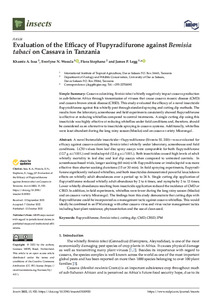| dc.contributor.author | Issa, K.A. |
| dc.contributor.author | Wosula, E.N. |
| dc.contributor.author | Stephano, F. |
| dc.contributor.author | Legg, J. |
| dc.date.accessioned | 2023-04-20T08:05:20Z |
| dc.date.available | 2023-04-20T08:05:20Z |
| dc.date.issued | 2022-10-12 |
| dc.identifier.citation | Issa, K.A., Wosula, E.N., Stephano, F. & Legg, J. (2022). Evaluation of the efficacy of Flupyradifurone against Bemisia tabaci on cassava in Tanzania. Insects, 13(10): 920, 1-18. |
| dc.identifier.issn | 2075-4450 |
| dc.identifier.uri | https://hdl.handle.net/20.500.12478/8145 |
| dc.description.abstract | A novel butenolide insecticide—flupyradifurone (Sivanto SL 200)—was evaluated for efficacy against cassava-colonizing Bemisia tabaci whitefly under laboratory, screenhouse and field conditions. LC50 values from leaf disc spray assays were comparable for both flupyradifurone (12.7 g a.i/100 L) and imidacloprid (12.6 g a.i/100 L). Both insecticides caused high levels of adult whitefly mortality in leaf disc and leaf dip assays when compared to untreated controls. In screenhouse-based trials, longer soaking (60 min) with flupyradifurone or imidacloprid was more effective than shorter soaking durations (15 or 30 min). In field spraying experiments, flupyradifurone significantly reduced whiteflies, and both insecticides demonstrated powerful knockdown effects on whitefly adult abundances over a period up to 24 h. Single cutting dip application of flupyradifurone reduced whitefly adult abundance by 2 to 6 times, and nymphs by 2 to 13 times. Lower whitefly abundances resulting from insecticide application reduced the incidence of CMD or CBSD. In addition, in field experiments, whiteflies were fewer during the long rainy season (Masika) and on cassava variety Mkuranga1. The findings from this study demonstrate that cutting dips with flupyradifurone could be incorporated as a management tactic against cassava whiteflies. This would ideally be combined in an IPM strategy with other cassava virus and virus vector management tactics including host-plant resistance, phytosanitation and the use of clean seed. |
| dc.description.sponsorship | BAYER Crop Science |
| dc.format.extent | 1-18 |
| dc.language.iso | en |
| dc.subject | Cassava |
| dc.subject | Bemisia Tabaci |
| dc.subject | Food Security |
| dc.subject | Climate Change |
| dc.subject | Plant Diseases |
| dc.subject | Tanzania |
| dc.title | Evaluation of the efficacy of Flupyradifurone against Bemisia tabaci on cassava in Tanzania |
| dc.type | Journal Article |
| cg.contributor.crp | Roots, Tubers and Bananas |
| cg.contributor.affiliation | International Institute of Tropical Agriculture |
| cg.contributor.affiliation | University of Dar es Salaam |
| cg.coverage.region | Africa |
| cg.coverage.region | East Africa |
| cg.coverage.country | Tanzania |
| cg.coverage.hub | Eastern Africa Hub |
| cg.researchtheme | Plant Production and Health |
| cg.identifier.bibtexciteid | ISSA:2022 |
| cg.isijournal | ISI Journal |
| cg.authorship.types | CGIAR and developing country institute |
| cg.iitasubject | Agronomy |
| cg.iitasubject | Cassava |
| cg.iitasubject | Climate Change |
| cg.iitasubject | Food Security |
| cg.iitasubject | Plant Breeding |
| cg.iitasubject | Plant Diseases |
| cg.iitasubject | Plant Health |
| cg.iitasubject | Plant Production |
| cg.journal | Insects |
| cg.notes | Open Access Journal; Published online: 12 Oct 2022 |
| cg.accessibilitystatus | Open Access |
| cg.reviewstatus | Peer Review |
| cg.usagerightslicense | Creative Commons Attribution 4.0 (CC BY 0.0) |
| cg.targetaudience | Scientists |
| cg.identifier.doi | https://doi.org/10.3390/insects13100920 |
| cg.iitaauthor.identifier | EVERLYNE WOSULA: 0000-0001-5693-0889 |
| cg.iitaauthor.identifier | James Legg: 0000-0003-4140-3757 |
| cg.futureupdate.required | No |
| cg.identifier.issue | 10 |
| cg.identifier.volume | 13 |

